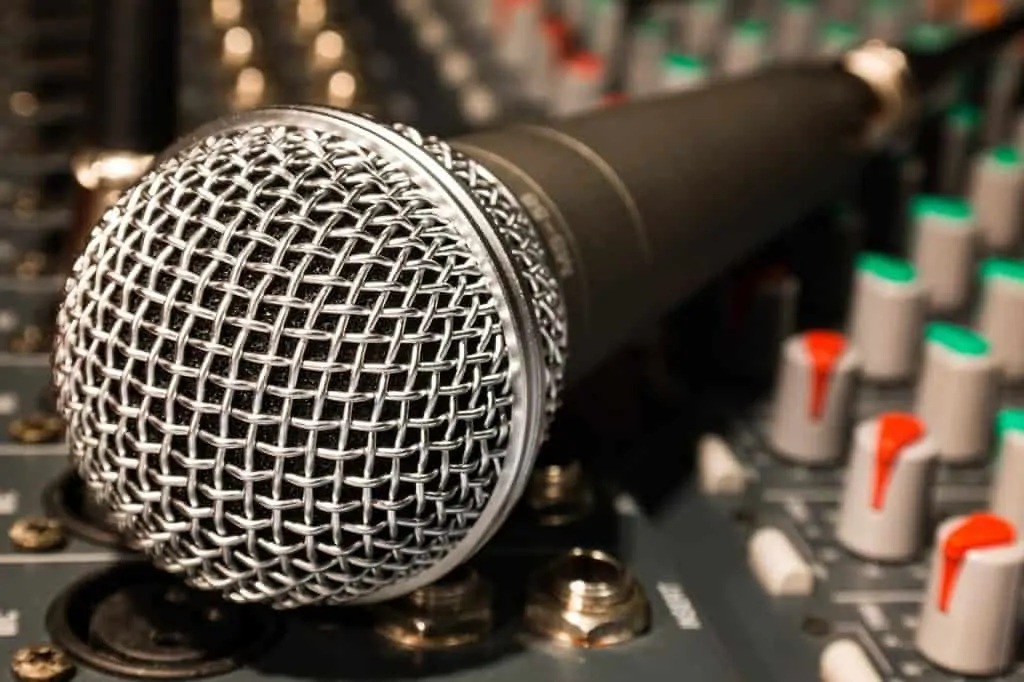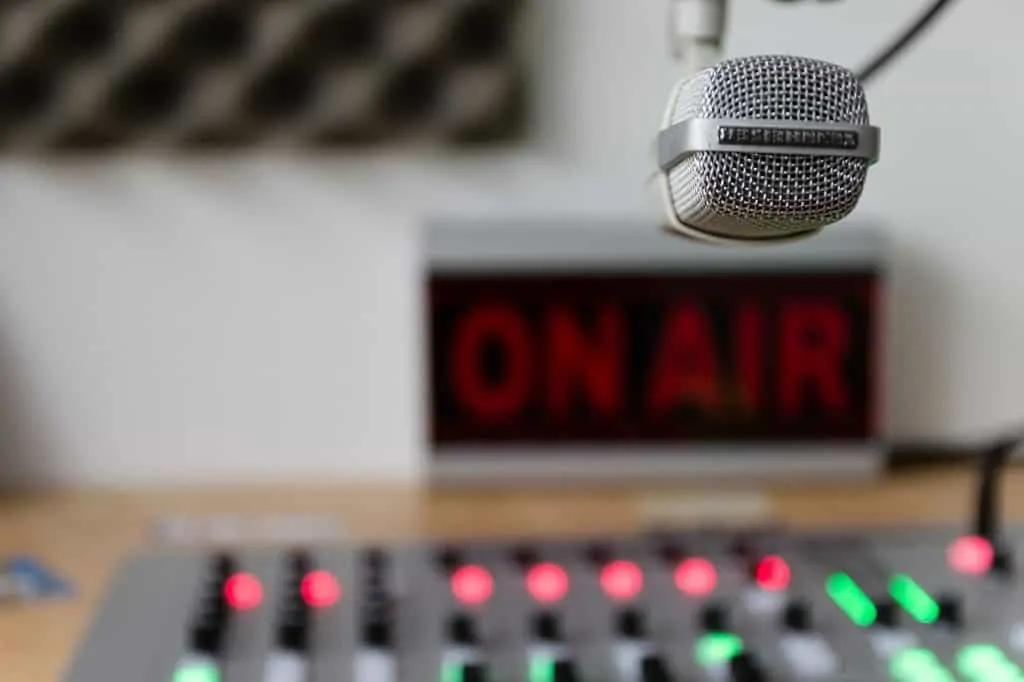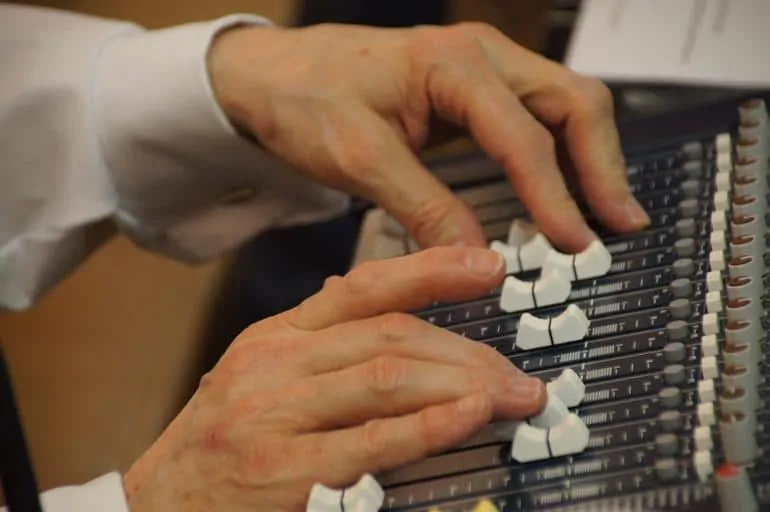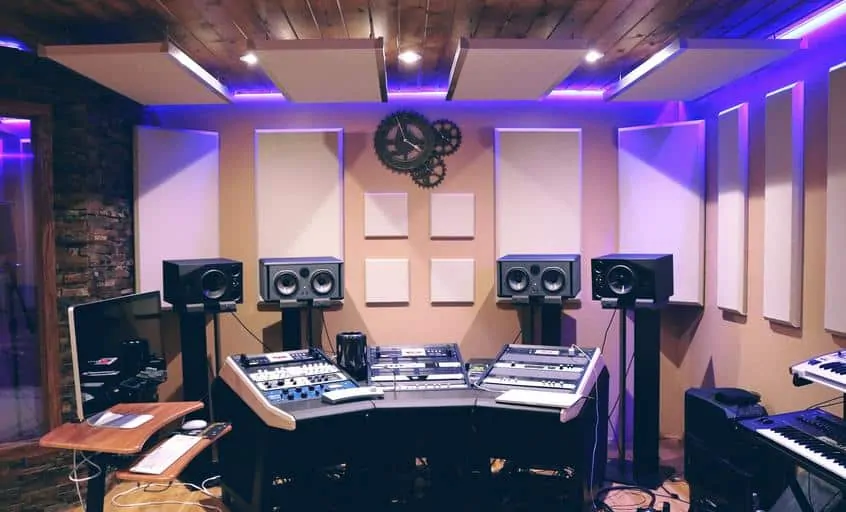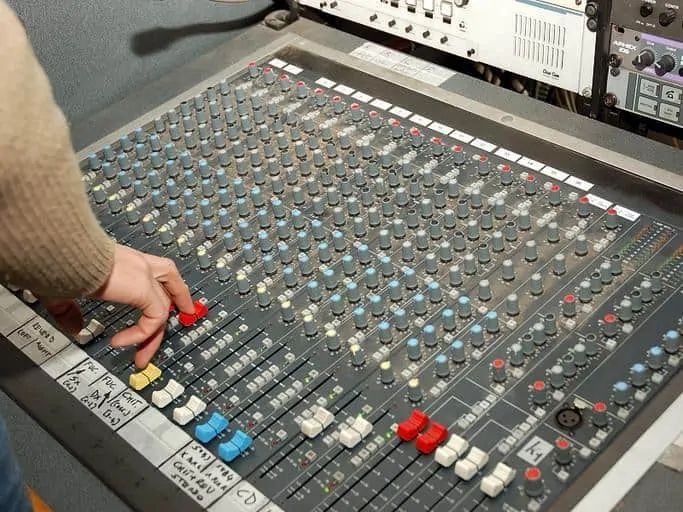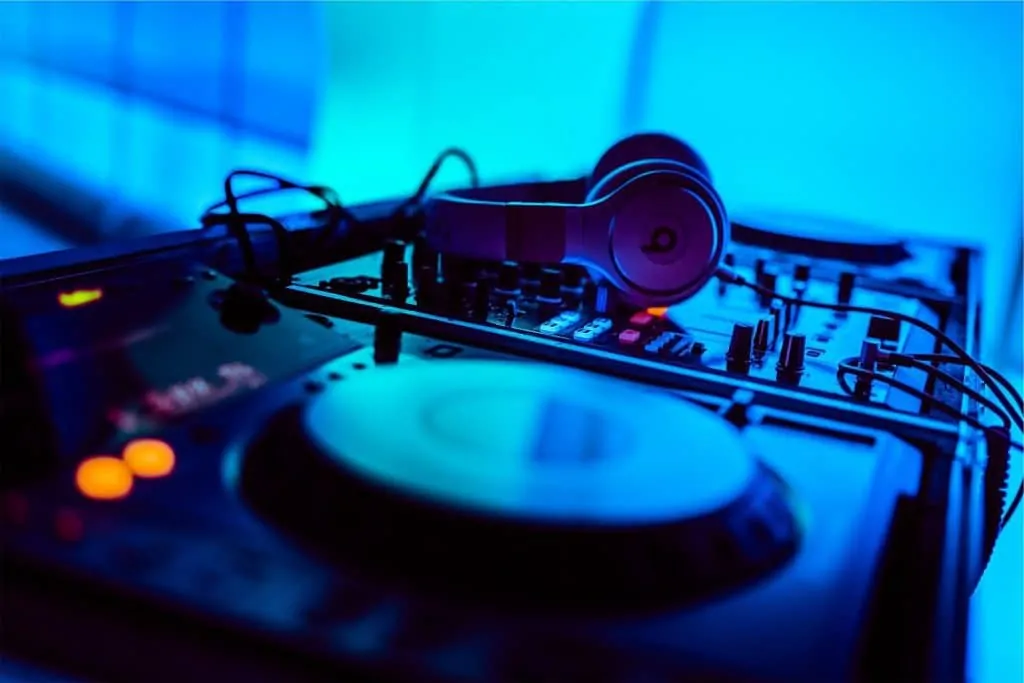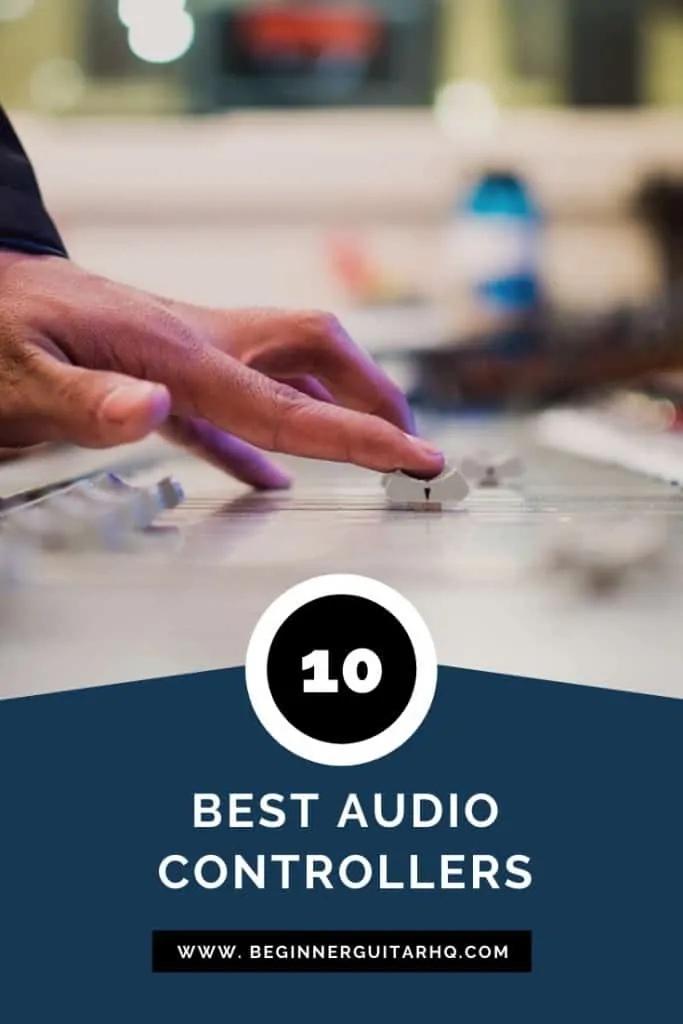In this buyer’s guide we dig deep into how to choose the best audio mixer.
There are basically 3 kinds of mixers suited for different professions, all of which I took into consideration for my list:
- Recording studios (music, TV, film, broadcasting, etc);
- Live musical shows;
- DJ.
We’re also covering the basics of consoles. Think of it as an “audio mixer 101.” During this portion, I shared some mixers as an example of what I’m explaining.
Furthermore, we’re sharing with the things to look for when buying a mixer. I want you to make an informed decision.
And lastly, we’re sharing with you our selection and review of the top 10 audio mixers you can buy right now. I added a subtitle on every item letting you know the best application -profession- for each particular console.
Overall, we’re featuring beginner, intermediate, and a couple of advanced mixing consoles.
Contents
How budget are we talking about?
First of all, let’s talk about your needs. What do you need a mixer for? Is it your home studio? A TV/film studio? Live venues? A rehearsal room?
The reason will let you know how big your mixer is going to be, and thus tell you more or less how much it will cost you.
Secondly, when shopping for a mixer, you could also consider getting a completely live sound package. These are bundles that include most or all of the audio gear you need to perform live. These packages often include speaker stands, speakers, monitor speakers, a powered mixer, and the cables you need. Some also include microphones.
Check my previous PA system buyer’s guide to get you started. A PA system is how you would know your live sound setup on the industry.
The idea of getting a bundle is getting a bunch of musical gear that’s already been tested and matched together, so you don’t have to worry about the compatibility. More so, these bundles are more affordable.
Here’s an all in one PA system I recommend:
A single-portable unit with in-built mixing capabilities is as budget as you can get.
However, going for a separate mixer will give you more flexibility and possibly better audio quality.
I’m sharing with you the best mixers with entry-level prices and then go all the way up to triple-zero units. These high-end, bigger alternatives, offer better EQ alternatives and can give you an overall better sound.
Keep in mind digital mixers are more expensive, so they belong to the higher-end of the budget spectrum.
A complete live sound setup would be ideal if you’re looking to handle your band’s sound by yourself
Mixer 101
A mixer combines and processes audio signals, and then routes it forward to where it needs to go. As part of its primary functions, a console also monitors audio.
Mixer desks live in four types of environments, mostly:
- Live shows;
- Recording studios;
- Broadcast audio;
- Clubs and discotheques;
- Television and film.
Other names people know it for are audio controller, audio console, audio mixer, mixer console, mixing board, mixing desk, soundboard, or simply console. All of those titles refer to the same device.
Nowadays, there’re different kinds of devices offering mixing capabilities, which include apps for mobile devices and music production software (DAW) for computers.
A mixer can change the levels and quality of audio signals. It represents the most convenient way to route and combine different audio signals, change their tune, and tweak their dynamics.
Today’s high-end mixers can effortlessly mix digital and analog audio signals. Furthermore, they can integrate your audio with a video for a consistent audiovisual (A/V) experience.
Every radio station, recording studio, and TV & film studio has an audio mixer.
Live sound 101
Any A/V experience consists of a series of mic lines, instrument lines, and audio and video lines going to a mixer. The mixer processes the signal and then sends it forward to PA speakers (speakers designed for live events), and stage monitors (speakers pointing towards the performers so they can hear themselves).
Some PA speaker builders are entering the mixer market by selling speakers with in-built mixing capabilities.
What a mixer does
According to musical site Kettner Creative, the core function of a mixing desk is taking two or more audio signals, merge them together, and create an output signal with a balanced sound.
The audio engineer controls the sound like an orchestra conductor controls the orchestra. He makes sure every individual melody, instrument, or sound source mesh together in a single harmonious end product. Thus, the mixer has to optimize and filter the sound by adjusting volume and gain levels, EQ, and effects. Plus, he needs a monitor feed, which means listening back the mix with a studio monitor.
The key components of a mixer
A mixer might look like an airplane to you, so I’m here you out with the key components every mixer has:
- The board: is the layout containing the various controls. There’re two basic layouts for boards: in-line and split.
In-line consoles have the monitoring section and the input section in the same channel strip. Split mixing consoles have both sections in different halves of the board. In my experience, split mixers are easier to handle.
- The master section: it’s the area providing adjustments to all of the channels. It’s typically in the middle of the desk, so its also known as the “Centre Section.”
Common adjustments include master gain, master volume, master EQ; as well as master levels for the busses and aux channels.
- Inputs: these are the entry point for the different sound sources. They connect to the console via plug-ins commonly at the unit’s rear.
Usually, inputs include XLR (for microphones), 5 mm jack (for headphones), unbalanced ¼’’ input (for instruments), and RCA (the A/V input).
- Outputs: These are the connections to outside devices. Consoles usually have a stereo output, which uses two output sockets that are fairly easy to locate.
The outputs often include XLR connections, 6.mm audio jack (for some audio equipment), and RCA sockets.
You can monitor the output’s level with the console’s VU meters. It’s ideal that you keep the peak around 0dB or bellow.
Mixer outputs may also include either a dedicated monitor feed or a headphone’s output, both of which you can adjust independently.
- Channel equalization: EQ allows you to adjust and control low (bass), mid, and high frequencies (treble) for each channel.
Remember each input connection represents a channel, and each channel has its own EQ buttons. And so, each channel has the following elements:
- The input section, which may have a gain knob to adjust the incoming signal
- EQ, whereas the EQ quality depends on the mixer’s budget.
- Dynamics, however only on higher-end mixers. Common dynamic effects are compressors and gates. When you engage the dynamic switch, the compressor makes the signal more even, while the gate tries to keep unwanted background noise out.
- Fader, which raises or lowers the amount of audible signal from the channel. Faders allow you to lower or raise the presence of each channel as it goes to the final mix. It’s the most important factor in the mixer.
- Group faders, which control multiple faders at once.
- Auxes, which are outputs designed for creating a headphone mix
- Bus assignment, which tells the signal where it should o (like an audio interface or a headphone)
- Pan, which pans the channel’s signal right or left of the stereo audio spectrum.
Now that we have reviewed the components of a mixer, let’s read about its basics.
Every channel has its own EQ, volume, gain, and fader nobs.
What a mixer can do
Every single mixer has the same functions, no matter how ridiculously complex it looks. What varies is the way they perform their functions, which depends on the needs and budget of the user.
A mixer basically combines the signals from their sources (like an electric guitar or a microphone), processes them, and produces acceptable levels of balance and quality. Then, it passes the resulting mix into a recorder, a broadcast chain, or a PA system.
Mixers carry at least 1 channel, each of which is capable of plugging instruments and microphones. Plus, they have knobs and tools to customize the sound of both line levels. The console also gives users the ability to listen and meter each individual channel, the master mix, and alternative output mixes.
Furthermore, the console can create independent mixes for effect units, cue feeds, and multi-track recorders like DAW software.
A music recording studio mixer can have fewer channels as, usually, only one instrument records at a time.
And, lastly, some mixers have extra connectivity features that let you control the mix with a mobile app or with a computer.
How a mixer works
First, the mixer optimizes the input signal from an instrument or mic cable. After that, the signal goes through the console’s EQ before it reaches the channel fader.
- IMPORTANT NOTE: When the signal first hits the console, at the input stage, there’s an onboard microphone preamplifier. The design of this preamp is a strong indicator of the sound character of the mixing board. Losses in quality at this initial stage cannot go back, so the preamp is very important. This is why recording studios use very high-end external mic preamps.
Aux outputs are immediately before or after the fader, just like insert points. They can extract the mixer’s signal to process it with another device (like external compressors, noise gates, or effect pedals), and then return it to the mixer to continue the process.
Once this step is done, the console moves the signal to groups and outputs as needed. If there’s a need for a group, it’s because there’s an additional equalizer phase within the groups before the signal reaches the fader.
The group feature exists to give users the ability to easily control a large number of signals or channels at once.
And that’s pretty much how audio mixers work.
Remember, the most important factor is the mic preamp. Its job is pretty tough: it must provide a sufficient amount of signal gain, keep the background noise at a minimum, and provide enough headroom so that peaks don’t cause overloads and distortions. Furthermore, it has to capture the sound with detail and precision.
Every mixer, no matter how big it is, has the same basic components.
Where do you use audio mixers?
The most obvious place to find a console would be a recording studio or a post-production studio. You simply can’t record an album, a soundtrack, or the sound of a TV episode without a mixer.
Outside of technical sound recording studios, you can find mixing desks at DJ booths on clubs and discotheques. Also, any event using a live sound setup (a PA system), like a wedding concert, a showcase, a conference, and so on.
In summary, here’s where you could find a console:
- Recording mixers, known as studio mixers;
- Live sound mixers, known as PA mixers or sound system mixers;
- DJ mixers.
Consoles come with a wide array of designs and configurations suited for different tasks. In particular, they come in either analog or digital versions, which are newer.
Even so, once you get a hold on its essential components and mechanics, there’ll be no difference for you between a 40-channel behemoth and a beginner’s 4-channel board.
The main difference, though, is between analog and digital mixers.
Analog vs digital mixers
Analog mixers have been around for decades, while digital mixers came into the music industry by the 1990s. Since then, digital mixers have grown to have almost as many capabilities as the classic analog consoles but for less affordable prices.
As software-based audio mixing is becoming more and more powerful thanks to modern computers, it’s time to consider digital mixers as the main alternative. Either way, let’s look at the capabilities, weaknesses, and strengths of each one.
The basics of analog mixers
Analog mixers remain the popular choice because of their lower cost and ease of use. You control all of their functions with physical knobs, so their operation is more intuitive than digital boards.
The downside is, as all of the controls are physical, these devices are larger. It represents a disadvantage in small home studios or cramped stages.
Nevertheless, analog mixers are capable of transmitting a very high-quality song. Its circuity-design and mic preamps are the most important factors.
Well-designed mixer mic-preamp boost the mic’s output without coloring or distorting the sound.
Here’s a well-designed Soundcraft analog mixer with extra phantom power for condenser microphones:
The basics of digital mixers
Digital mixers are harder to use as they have most of their functions hidden under menus on their LCD screens.
However, they have a wider selection of effects and possibilities. Such possibilities include pre-programmed effects and presets you can trigger with the simple touch of a button.
More so, some digital mixers are compatible with third-party software plug-ins that can extend their capabilities further.
Another huge advantage of digital mixers is how they can save and recall mixers. You can store past settings of previous performance on a USB flash drive or the mixer’s internal memory. Then, you can recall a previous mix during a venue from a prior similar venue and save a lot of time and effort.
However, you may find their price as their biggest downside. Such flexibility comes with a price. Plus, the learning curve to learn all of its possibilities can be quite large.
Here’s a 24-channel professional digital mixer with top-notch mic preamps:
Now, both analog and digital mixers can be powered or unpowered. Let’s review:
Powered vs. unpowered mixers
Powered mixers eliminate the need to bring a separate power amplifier to drive them. However, if you want to handle your live performance with these devices, your monitor speakers have to be unpowered.
Powered consoles have a wide range of configuration and sizes: they can ship with two channels for an acoustic guitar and a singer; or over 20 channels for a high-end console with a wide array of effects, mics, instruments, and powerful monitor speakers.
They might be more delicate to use, though, as you need to calculate the power you will need to drive your stage monitors and PA speakers.
On the other hand, an unpowered mixer needs a separated power amplifier. They can give you more headway to tweak the sound, but also represent another level of complexity and thus may require an extra sound engineer.
If you’re a single performer, a small band, or a band without too much budget, I recommend you go for powered mixers.
DJ mixers
A DJ has a unique set of needs and thus have a unique kind of audio mixers. DJ consoles meet these needs, interact with additional DJ gear and bring the boom into a club’s PA system.
DJ mixing boards feature particular characteristics compared to the rest of the consoles.
DJ boards include turntables or CD players plus some form of track selection (like an LCD screen to shift between songs you plug with a USB flash, a computer, or the board’s internal memory).
Entry-level DJ boards include two or three inputs and outputs, offer volume and EQ controls, fade knobs, crossfade operations, and turntable operations.
High-end DJ mixers add extra features like kill switches to instantly control certain frequencies; or metering to display distortion and output levels; and dozes of EQ controls, effects, and even video and light control.
They also allow connecting to a laptop computer and integrate with DJ software like Traktor DJ and DJ music-making software like FL Studio. It extends the mixer’s capabilities.
Here’s a great DJ mixing board with a 4.3’’ LCD screen:
Things to look for in a mixer
Let’s close our 101 section with a quick review of the things you should be on the lookout when buying your mixer.
There’re a lot of possibilities out there, so I’m helping you narrow your selection:
Application
Are you a DJ, or are you looking for a mixer to record, play live, or both?
A recording mixer needs top-notch preamp quality and the ability to plug in external processors.
A PA mixer needs to be compatible with your existing live sound system and offer you enough I/O to handle the entire band. More so, they need to be sturdier than studio mixers.
And, lastly, DJ mixers offer distinct capabilities, as we read below.
I/O and channels
Take into consideration how many mics and instruments you need to connect. For example, a drum kit can use four or five channels by itself.
More so, if you’re using condenser mics you need inputs that supply phantom power. Additionally, if your band has stereo keyboards and similar instruments, you’ll need stereo channels.
If you want to connect the bass or an electric guitar directly to the console (which is fairly common), you need sufficient direct inputs.
It’s always a good idea to have more channels than you think you need.
Signal routing and buses
These are important features for a recording mixer. If you use special mixes like for the monitors and headphones, you will need to have some flexibility on your signal paths.
EQ options
As you look for more and more sophisticated EQ options, the price goes up. SO, how sophisticated are your EQ requirements?
Generally, a recording studio requires finer EQ options, whereas DJ and live sound mixers can go on with simpler bass, mid, and high-frequency tweaks.
Here’s a tutorial video about the audio mixer’s EQ section:
Effects and additional sound processors
Do you use effect pedals or mic preamps? Extra tone tweaking gear makes your internal mixer less of a requirement.
On the other hand, if you’re looking for a mixer with onboard effects and sound processing, you can have a very portable live sound setup for your live venues.
Top 10 audio controllers
Here are the top 10 audio controllers 2019 you can buy right now. I’m reviewing each mixer so you can make a desition.
Mackie ProFXv2 – best overall affordable sound console –
The Mackie ProFXv2 is one of the best affordable audio mixers in the market right now. I would say it’s an essential gear for any starting musician.
The v2 model is part of Mackie’s ProFX series that kickstarted in 2018. In about a year, it has already gotten plenty of fame and high-rated reviews.
This is an 8-channel analog mixer with USB connection, 4 high-quality Vita Mic Preamps, and a 7-band Graphic Equalizer. Plus, it ships with a mixer 20 and a 20’ heavy-duty XLR mic cable.
There’re different versions of this Mackie board. You can get a small 4-channel affordable console all the way to 30 channels.
The ProFXv2 is a complete live sound solution that covers a wide arrange of applications. It delivers top-notch sound quality with the brand new Mackie Vita preamps, which reduces background noise and offers a high dynamic range for the microphones. It means it will capture great detail on low, mid, and high frequencies.
I personally love its new ReadyFX effects engine. It delivers 16 rich effects to greatly improve your performance. It includes reverbs, choruses, delay, channel compression, and dynamic control.
Furthermore, the mixer includes a live sound toolkit with a flexible I/O and a built-in USB interface for recording and playback.
Lastly, the ProFXv2 is quite sturdy as it has a steel chassis protecting it from your touring life.
Applications
- Sound mixing
- Clubs and discotheques
- Gyms
- Banquet halls
- Wedding parties or bands
- Houses of worships
- Conference rooms
- Boardrooms
- Video post-production
- Studio and field recording
- Broadcast.
Yamaha EMX50114C – best overall live sound console –
The price goes up a bit with this Yamaha digital mixer and for a good reason. If you have some money to invest in some advanced features, this is a great option.
The Yamaha EMX50114C gets you 15 inputs and 10 channels with single-knob compressors on the first 6 channels. It also features stereo master faders, an 80 Hz high-pass filters to reduce rumble, and a Feedback Channel Locator system to reduce feedback.
Furthermore, it features a great amount of power on their amps, with either 500W; 200W, or 75W per channel.
The distinct feature of the EMX5014 is its single-knob compressors. They are easy to use, easy to locate, and will help you control the vocals, keep low frequencies tight, and keep the different signals leveled.
More so, it has a user-friendly interface that allows you to very easily control and monitor its 9-band graphic EQ.
Applications
- Stage sound
- Rock bands
- 3 to 6 member bands
- Indoor concerts
- Rehearsal studios
- Video post-production
- Conference rooms
Behringer XENYX 1202 – best entry-level console –
Behringer builds budget-friendly audio gear. They probably have the best quality over value audio gear on the industry.
The Behringer XENYX 1202 is one of the cheapest consoles in the market. It’s both worthy and affordable and represents a simple solution for your musical needs.
It’s an analog board with 4 channels, 12 inputs, and 4 mic preamps. It has a post-fader FX for each channel and a 3-band EQ at the master section. Behringer alls the EQ “Neo-classic Britsh” and says it brings warm and rich tones.
Behringer calls it “British” because it evokes the British consoles from the 60s and 70s charging the sound of the British Invasion bands (Led Zeppelin, The Beatles,…). In fact, the circuitry is based on those vintage circuits.
It has XENYX 1202FX mic preamps, which are modern, state-of-the-art devices that compare really well to high-end mic preamps.
It also features a studio-grade stereo FX processor with 100 presets. The FXs include chorus, delay, flanger, reverb, pitch shifter, and several multi-effects.
Plus, it has CD inputs and features some great headroom to reduce low noise and keep distortion and overloading at bay.
Lastly, it has 2 48V phantom power if you’re using condenser mics.
Applications
Simply put, this Behringer XENYX 1202 console is small and compact and it’s simply the best audio controller for smaller applications.
- Home studio
- Small performances
- 1-man band
- 3 member bans without drum kit
- Broadcasting & radio
- Recording studio
- Commercial studio
Alto Professional ZMX52 – best beginner mixing console –
This is the best beginner mixing console because it’s pretty straightforward and ships with the lowest price of the list.
It has 6 inputs with phantom power XLR inputs on each channel. I personally love the mic preamps on this device, which give you a sound quality that goes way beyond its entry-level price.
More so, the circuitry offers plenty of headroom, which allows you to control the dynamic range and eliminate ultra-low-noise.
The Alto Professional ZMX52 also has a 2-band EQ on the mono channel to create a warm, natural sound.
The I/O section includes a ¼’’ main input, headphone & aux outputs; mic input channel XLR and a balanced line input for instruments; and two stereo input channels.
Applications
- It’s a good choice for solo musicians looking for a compact and capable mixer they can carry from the studio to a small gig.
- Live sound for to 3 member bands without drummers
- Live sound for solo performers
- Recording home studio
- Rehearsing home studio
Allen & Heath ZED-10FX – best multipurpose mixing console –
Allen & Heath makes superb audio gear and, when it comes to mixing boards and DJ consoles, they take the cake.
The Zed-10FX is great for live sound and excels at recording and regarding affordability, it offers great value for the money. Speaking about mixers -which is a particularly complex audio gear- the Zed-10FX still lives on the affordable side of the spectrum.
As the name implies, the Zed packs onboard digital effects which are perfect for the studio and okay for live scenarios. These effects include reverb, delay, flanger, chorus, and tremolo.
This particular mixer is a solid and portable build with 10 channels with both mic and line inputs. Channels 1 to 4 feature an XLR mic input and low-noise preamps, whereas channels 1 & 2 offer both balanced and unbalanced line inputs.
Channels 3 & 4 have Hi-Z inputs to directly connect an electric instrument like a guitar or a bass. These inputs feature Class-A FET circuits which add tube-like warm tones to your instruments.
All of the four mono channels have responsive 3-band EQ with MusiQ technology to optimize the sound.
Plus, it features top-notch mic preamps on each one. Also, it has 2 Hi-Z guitar inputs (inputs designed for electric guitars), two stereo inputs for effect returns, and a portable music player.
It completes your home studio with an extra USB digital audio interface you can plug to Mac and WIndows and start recording instruments (connected to one of the channels).
This compact multipurpose Allen & Heath mixing board ships with a carrying bag.
Overall, I recommend this mixer for anyone wanting to get serious into home recording. More so, if you additionally want to carry it on stage, this mixer offers plenty of options for small bands: with a laptop, mics, and speakers, you’ll have a fully-fledged PA system.
Applications
- Home studio recording
- Small gigs
- Live gig recording
- Small PA systems
- Small A/V experience
- Conference rooms
- Houses of worship
- Schools.
Behringer X Air Digital Mixer – best affordable digital console –
The Behringer X Air Digital Mixer is an excellent small digital board wth built-in wifi router for easy and direct operation.
What I love about this particular model is the number of advanced features and the quality of its sound shipping on such a compact mixer. Its supreme mobility comes with superb power. Plus, it seamlessly integrates with your macOS, Windows, iPad, iPhone or Android devices with a remote control app.
The mixer also includes 4 onboard FX and a state-of-the-art auto-mixing feature.
With its modern integration of technologies and sonic features, it gives you an easy, high-end experience with a very intuitive interface.
The X air has 4 channels: it has 2 TRS aux outputs, 2 XLR main outputs, and a headphones connector. Its controls aim for easy use so you can focus on the sound rather than how it works. Furthermore, it has USB connectivity and stereo recording.
Applications
- Because it only has four channels and not too many effects whereas it has great sound quality, I recommend this as your main studio mixer
- Broadcasting
- Podcasts
Budget alternative: Yamaha Mg10Xu
There’s a similar mixer by Yamaha selling less price. It has 10-inputs (the cheapest one) all the way up to 20 inputs.
The Yamaha Mg10Xu digital mixer has studio-grade mic preamps; a 3-band EQ with a high-pass filter; and physical knobs for the compressor, which can give you punchier bass lines, leveled guitars, cleaner vocal sound, and a tighter drum kit.
PreSonus StudioLive 16.4.2AI – best high-end digital console –
PreSonus tries to emulate the easiness of an analog mixer in this digital device. Then, they ship it as a professional recording solution with more processing power and advanced features than analog mixers of the same price range.
This is the top-of-the-line audio gear. If money is not a concern for you, this is the best console you can find in the market. So, if you’re looking to invest into a huge board that gives you the best sound quality and makes your mixes stand from the crowd, the StudioLive 16.4.2AI is your choice.
This particular model (and the different models of the StudioLive series) has up to 16 channels, 6 mic XMAX mic preamps (which are as advanced as you can get). It has 16 buses with 4 subgroups, 6 analog auxiliary buses, and 4 internal FX buses. Plus it has a stereo main mix.
It also has a FireWire 800 audio interface that simplifies your experience, a wireless remote control, and a “Fat Channel” processing a 4-band parametric EQ. Furthermore, it has compressor, limiter, gate, and other essential effects.
What’s best, all of its controls are intuitive and feature a physical knob. There’re no layers, no screens, and no menus to get lost on, and your main mix is always under your nose.
More so, it ships with the Studio One 2 Artist DAW software. If you’re interested in recording, this will help you out. Studio One is one of the top 10 best music recording software nowadays. It also includes the StudioLive AI Software Library, which has a multi-touch control software with Smart audio analysis and system checks.
Plus, it includes the StudioLive Remote-AI app for iPad; and the QMIX-AI app for iPhone and iPod touch.
What I personally love is how deeply integrated the mixer is with PreSonus mixing software. The result is a system that has constant communication between its hardware and software to enhance every inch of its mixing process.
Lastly, StudioLive 16.4.2AI have a wireless connection to any routers or networks withs PCs, Macs, and iOS devices running the Studio AI Software Library.
Applications
- Sound mixing
- Music recording studio
- Post-production & TV
- Rehearsal studio
- Commercial studio
- Concert recording
- Acoustic concert recording
- Showcase.
Numark Party mix – best entry-level DJ mixing console –
This is an ultra-portable two-channel DJ controller that works with the Serato DJ Lite software, which ships with this package and is compatible with Windows and Mac.
It has a built-in light show with three LED light arrays that are able to fill the room. Even more, the lights can auto-sync with the music.
It features an onboard 16 bit / 44.1 kHz audio interface with 1/8 ‘ headphone output and a ⅛’ main output to connect with PA systems and other mixers. You can use the interface to connect the device to your computer and use it to record music. Feel free to read more about it on this home studio quick setup section.
Applications
- DJ board only. I recommend this as your first DJ mixing board.
Pioneer Pro DJ DJ Package – best beginner DJ mixing console bundle –
This Pioneer Pro DJ board is the perfect mixing console if you’re a beginner DJ or an intermediate DJ looking to upgrade your gear with some mid-budget investment.
This DJ mixing board has two turntables, two channels, and 3-band EQ on the master section. Like most DJ boards, it has a knob to slow or accelerate the tempo of a song.
You’ll find its 8 pads per channel extra handy. You can store loops, samples, effects, and song cues on them.
It has a PC Master Out for extra flexibility. It allows you to control the mix with your computer’s internal speakers or connected speakers. At the same time, there’s a Plug and Play feature that lets you play the mix with a built-in sound card.
More so, it packs plenty of features that can help you develop your skills. It includes dedicated cue buttons, Beat FX, looping controls, and more.
The Beat FX feature lets you apply professional FX, samples, and loops that automatically matches the tempo of the track. It will help you craft unique sounds and sets right out of the bat.
The result is an advanced DJ board that feels natural and easy to use.
What comes in the box?
The DJ Package of this particular bundle includes HDJ-X headphones that are able to hear the mix and track on board feedback.
It ships with a professional performance software rekordbox DJ which can help you improve and master your creative abilities. Simply activate the software with the license key you’ll find on the box, and then start DJing.
The software is compatible with macOS High Sierra, macOS X, and Windows 10,8.1, and 7. It needs at least 4GB RAM and an i3 or equivalent processor.
If you don’t want to use rekordbox, the Pioneer DJ board is also compatible with djay and webdj for iPad and iPhone; and edjing mix for iPad, iPhone, and Android.
Applications
- DJ board only
Professional MX-12 – most portable mixing console –
Compatibility is a factor you should be looking for when buying your mixing console. Thus, here’s a highly compatible board that works with Android devices, Apple iPad, iPhone, iPod, macOS, and PC.
These connectivity features deliver the most portable mixer of the list. You carry it around, plug, play and control it with your mobile device without too much hassle. It also makes for a really easy to use mixer, something that’s always a good addition.
It’s an analog mixer that features up t 12-channels plus an aux path with an onboard effects processors. Because of this, it’s easy to use the console, ideal for beginners and professionals alike.
Furthermore, the device features three 3-band EQ and a 48V phantom power for condenser mics on each channel (each channel has a mic input).
Lastly, it has 2 built-in USB flash reader that allows you to play music from USB flash drives
Applications
- Live sound
- Commercial recording
- TV sound post-production
- Film sound post-production
Final Considerations
Thank you for reading my 2019 audio controllers buyer’s guide. I hope my console reviews helped you make an informed desition.
If you ask me, I would go for the Allen & Heath Zed-10FX. If you’re looking to build a complete PA system, check our recent articles:
I’ll write an article to help you build your complete PA system very soon, so you won’t have to worry about mixing and matching different components.
If you have any questions, please leave your comment below!

